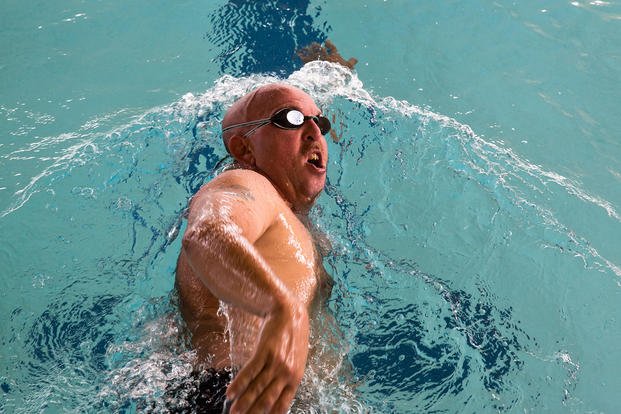The specialized combat swimmer stroke (CSS), also known as the combat sidestroke, is just a modified version of the elementary sidestroke. The modified version actually mixes in a few changes that resemble other known strokes.
Learning how to swim the freestyle, breaststroke and sidestroke will help you adapt to the newer CSS version of the stroke.
Here are the added changes: the freestyle arm pull (top arm), bottom arm scull and underwater recovery of the arms back to overhead of the breaststroke, the breathing of freestyle stroke, and the side position and long glide of the elementary sidestroke.
See the videos below for the movement of the discussed strokes.
Here are specific questions about the CSS and some common issues:
1. Should you constantly be inhaling/exhaling like a crawl stroke (similar to regular breathing) or pause and hold your breath for a bit after inhaling, before exhaling again underwater?
It is best to get in a breathing rhythm and not have to hold your breath during the CSS. However, it may feel like you have to hold for a few seconds after the kick off the wall and double arm pull out (breaststroke pullout), as that process of being underwater is about five seconds.
2. Do you exhale through the mouth, nose or both underwater?
This depends on how you will be tested. Typically, you will swim with no goggles or mask during the boot-camp physical screening test and with a mask during training (BUD/S, dive school, etc.). With a mask, you have to be a mouth breather. Without a mask, it is up to you.
3. Any extra tips or is there a different breathing method used for CSS that I didn't identify?
Turn your head as your top arm pulls past your face and inhale during the bottom arm pull (scull). Overall timing of the stroke is this sequence: top arm pull, bottom arm pull and inhale, kick and underwater arm recovery, glide. You typically will start the exhale at the kick and finish during the two- to three-second glide.
4. I cannot do a flip turn. Does that matter with this stroke?
No, you do not need to do a flip turn. In fact, they are not allowed during the Navy PST for BUD/S, SWCC, EOD and diver. You should learn how to do the open turn, though, as getting good at that can help save up to a minute off your time.
Here are some video explanations of the strokes that will help you become better at the CSS. You will see many similarities to the following strokes and techniques. The creators of the CSS utilized those strokes to make a more efficient underwater recovery stroke that can be a more stealthy option when you need to surface swim.
Elementary Sidestroke
You actually can use the sidestroke if you prefer. You can use the breaststroke as well during the Navy PST for Naval Special Warfare/Special Ops programs.
Freestyle Turn to Breathe/Top Arm Pull
The top arm pull and breath are the same in the CSS as the freestyle stroke. The recovery of the arm back overhead is different. The CSS requires that the arm be underwater during recovery.
Breaststroke Bottom Arm Pulls and Recovery (Scull)
Turnaround
Kick off/Pullout
All of these skills can be used with the CSS. The bottom arm pull is a short scull version, although many will make this a full stroke. Sometimes, the full stroke can be cumbersome to recover from and mess up the timing of the breathe/arm recovery phase.
The turnaround is an open turn, although you do not have to touch both hands on the wall with the CSS as you would with the breaststroke in competition. The kickoff and pullout off the wall will be the fastest 10 yards every turnaround you have, so make them good, strong and streamlined.
Stew Smith is a former Navy SEAL and fitness author certified as a Strength and Conditioning Specialist (CSCS) with the National Strength and Conditioning Association. Visit his Fitness eBook store if you're looking to start a workout program to create a healthy lifestyle. Send your fitness questions to stew@stewsmith.com.
Want to Learn More About Military Life?
Whether you're thinking of joining the military, looking for fitness and basic training tips, or keeping up with military life and benefits, Military.com has you covered. Subscribe to Military.com to have military news, updates and resources delivered directly to your inbox.
















